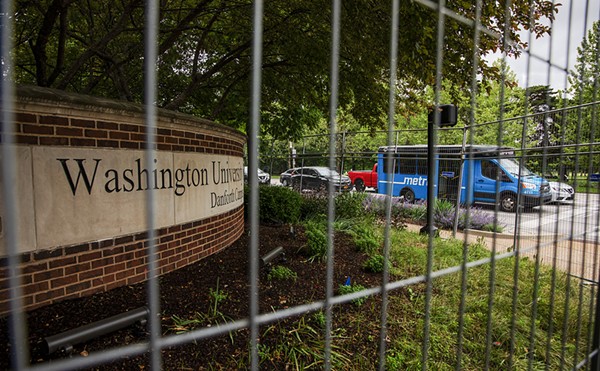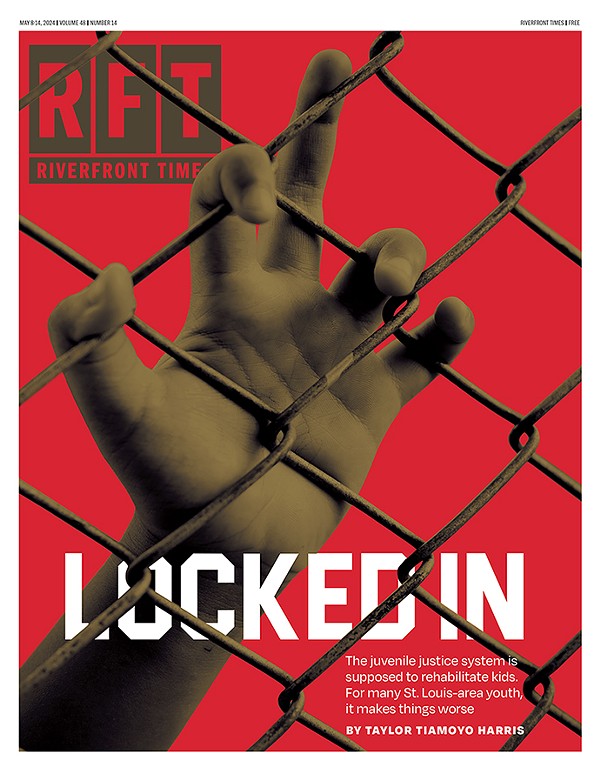"Ghost stories exist because most people want some kind of tangible connection to the past."
So says Christopher Gordon, director of the Missouri History Museum's Library and Collections, whose job title requires that he devote some time looking into local tales of the occult and paranormal.
Yet there's another reason why we love our lore and gore. "Most everyone appreciates a good scare," admits Gordon.
That's especially true this time of year as interest in St. Louis' urban legends grows. Some of these tales, handed down from generation to generation, date back nearly 200 years to the city's founding. Others were born around campfires within the past half-century. And while it's easy to dismiss most of these yarns as an out-and-out fallacy or exaggeration, some fables refuse to be laid to rest — no matter how outlandish their claims. Here are five of those tales.
Believe them...or not.
The Bubblehead Family of North County
On a windswept October evening, Carrico Road seems like the sort of place plucked right out of a Grimms' fairy tale. The winding stretch of asphalt disappears from one bend to the next. Fallen leaves swirl across the pavement, and at least eight signs along the shoulder of the roadway carry the same ominous message: No trespassing.
Somewhere in the thick woods beyond those signs, according to local lore, live the Bubbleheads. Some say they are a family who took experimental drugs that caused their heads to swell to the size of large pumpkins. The government — or the pharmaceutical company — bought them off and hid them away on this isolated road just south of the Missouri River in unincorporated Florissant. Others say that the Bubbleheads are an old St. Louis family with physical deformities from years of inbreeding. They keep to themselves, or they attack trespassers in a flurry of rage. Some stories about the area reference "hook men" who stalk the night, mysterious hitchhikers from the great beyond or simply ghosts with big, swollen heads.
Yes, Carrico Road is the kind of place where urban legends are born, though ask local thrill seekers for directions there, and you will likely get blank stares. People know it better as Bubblehead Road, and they've been coming here for at least 40 years — much to the dismay of residents.
A homeowner along Carrico Road who declined to give his name says interest in the myth seems to ebb and flow. Still, a couple times a year, he says, he'll wake up in the middle of the night to the sound of a car stereo blasting at full volume or maybe the squealing of tires.
"I know those are kids out there messing around, looking for the Bubbleheads," he says.
Dr. John L. Oldani, a retired professor from Southern Illinois University Edwardsville who has studied regional folklore for decades, says the Bubblehead tale follows a common pattern.
"It's one of those stories that relies on an FOF — a friend of a friend," Oldani says. "People will keep telling these stories, but it's always going to be a friend of a friend, maybe someone they know but can't name, who saw the Bubbleheads themselves or who picked up the ghostly hitchhiker."
Still, might the myth contain a kernel of truth?
John Goessmann, who inherited an old farmhouse on Carrico from his aunt and uncle six years ago, suggests there could be. He remembers a boy who lived at the far end of the street a long time ago. The boy had hydrocephalus, a medical condition that leads to swelling of the brain. Supposedly he would play outside wearing a helmet to protect his sensitive skull. Goessmann and others say the family moved away a long time ago — probably to seek privacy.
Yet the search continues for the Bubbleheads.
Randy Vaughn, a media-relations officer for the St. Louis County Police Department, remembers how trespassing and noise complaints kept him busy throughout the 1990s when he patrolled the area near Bubblehead Road.
"We've issued so many tickets and violations out of there over the years," Vaughn says. "Kids won't leave it alone, especially in summertime and around Halloween."
Molly Crenshaw: It's Hard To Keep a Good Woman Down
Molly Crenshaw may be the most well-known woman in the history of St. Charles county. At Francis Howell High School generations of students pass along the myth of Crenshaw — a bitter Haitian (sometimes Jamaican) woman who was allegedly lynched as a witch in the mid-1800s after villagers blamed her for a devastating crop failure.
In other versions of the story Crenshaw is a freed slave and a voodoo practitioner who cast spells on neighbors. Just before being murdered at the hands of the angry mob, Crenshaw warned that anyone who touched her grave would drop dead.
Legend has it that townspeople chopped her body into quarters, burying them across the countryside so that she would never rise again.
But the real Molly Crenshaw (actually Mollie Crenshaw), the one whose tombstone teenagers have been seeking out for half a century, wasn't a witch or a murder victim or an Afro-Caribbean woman. According to the obituary that ran in the now-defunct St. Charles Cosmo-Monitor, Crenshaw was a schoolteacher-turned-spinster who quietly ended her own life one morning with carbolic acid she'd purchased from a drug store.
The paper reported that she became despondent after losing her hearing with age. Crenshaw was also white, according to her death certificate, and died in 1913 — decades later than local legend has it. Moreover, she was buried not in four parts but in a difficult-to-find private family burial ground.
To this day Crenshaw's remaining descendents, relatives of her maternal uncle George Towers, have no idea how their ancestor became so infamous around St. Charles. It appears, though, that the legend really gained steam in the 1960s — a time when St. Charles was a hotbed for people interested in witchcraft. (Gavin and Yvonne Frost founded the the Church and School of Wicca in St. Charles in 1968 and successfully petitioned the IRS for recognition as an official religion before moving to North Carolina in the early 1970s. )
"The family seems to think that the legend did grow out of the real person.... She had a really unfortunate life, and it was an intolerant time," says Ray Castile, a local horror enthusiast and former journalist who has written several pieces on Crenshaw. "You can see how in schoolyards or something, people would make up stories about someone who was ill or disabled. There was so much stigma about suicide then. I'm sure it caused quite a commotion in St. Charles."
In the mid-1970s Crenshaw's myth was so entrenched that the reference librarians at the Kathryn Linnemann branch of the St. Charles City-County Library started keeping a file of genealogical information and newspaper clippings about her. By 1979 Crenshaw's popularity led the family to remove her headstone from their burial grounds.
Not that that has stopped the fun.
For several years in the early 2000s Joe Glenn operated a Molly Crenshaw-themed haunted forest in St. Charles county's Rotary Park in conjunction with the St. Louis Renaissance Faire. Like other Francis Howell alumni, Glenn (class of 1978) remembers scouring forests and old graveyards looking for the plots that held Crenshaw's remains. It was rumored that her severed body parts inched closer to each other with every passing year. In 2006 Glenn and some friends finally found the real Crenshaw's gravesite after consulting librarians.
"The funny thing is, we got there, and a few minutes later this big truck full of teenage guys shows up, and they're also looking for Molly's grave," says Glenn, who now lives in Florida. "It's a big part of local history."
Mark Twain's Ghost's Ghostwriter
In the spring of 1916 a dozen ladies from
St. Louis' society set gathered around a Ouija board, hoping to channel lost relatives. Instead they claim to have conjured up the spirit of America's greatest author, Mark Twain.
"Every scribe here wants a pencil on earth," the planchette spelled out as it moved across their board.
Twain had died six years earlier with unfinished business, according to the spirit that identified itself as "Lazy Sam," or Samuel Clemens (the author's legal name). Mark Twain still had a few more books in him, and he had in mind the perfect ghostwriter. That person, participating in the séance that day, was Emily Grant Hutchings, a formerresident of Hannibal, Twain's birthplace.
One of the most celebrated journalists of her time, Hutchings had made a name for herself as a freelance writer for national magazines such as the Atlantic Monthly and Cosmopolitan, and as the anonymous pen behind the St. Louis Globe-Democrat's juicy gossip column.
She was also a budding spiritualist who, with the help of a medium named Lola Hays, dived into the months-long task of transcribing Twain's novel letter by letter through the Ouija board.
In the fall of 1916 Hutchings published Jap Herron, the story of a Missouri farmboy born into poverty who becomes a cutthroat newspaper publisher. The subtitle of the work read: "A novel written from the Ouija board."
An editor for the San Francisco Chronicle marveled at the book's authenticity, adding that two women couldn't possibly invent Twain's trademark profanity and sauciness. A review from the New York Times was less complimentary of the 230-page novel: "If this is the best that 'Mark Twain' can do by reaching across the barrier, the army of admirers that his works have won for him will all hope that he will hereafter respect that boundary."
Meanwhile, Hutchings soon found herself in trouble with Twain's daughter, Clara Clemens, and the author's former publisher, Harper & Brothers (now known as HarperCollins). Both sued on copyright claims, and Hutchings and her publisher agreed to discontinue publication.
Henry Sweets, curator of the Mark Twain Boyhood Home & Museum in Hannibal, says that despite the embarrassment caused by Jap Herron, Hutchings and her husband, Edwin, remained committed to exploring proof of life after death. The couple never had any children, and Emily Hutchings died in relative obscurity in 1960 in her home in the Central West End. She'd reportedly suffered dementia for many years. In obituaries, few remembered her as anything more than the widow of Edwin Hutchings. No mentions were made of her literary career or love affair with the Ouija board.
Miles Hochstein, the son of Emily's grand-niece, says spiritualism does not run in the family. He recalls his mother referring to Emily dismissively, often mocking her claims to the spirit world.
Hochstein, a professional genealogical researcher who lives in Oregon, says he tried to read his great-aunt's novel but could never finish it.
"If you pick up Jap Herron, you will see that it is more or less unreadable," he says. "That was my experience, anyway. It is truly an awful piece of writing."
He says the family was never sure if Aunt Emily was a sincere spiritualist or a fraud out for a quick buck. According to family lore, Emily was the "alternative" sister, the one who often struggled to make ends meet.
In 1932, Cyril Clemens published a book of letters that belonged to his famous cousin, Samuel. Included in the trove were at least two fan letters from Emily Hutchings from the summer of 1902, after she'd met Twain at a reading in St. Louis. According to Sweets at the Mark Twain museum, the famous novelist and humorist scrawled the word "Idiot!" on the envelope of Hutchings final letter before filing it away in a box.
Monkey Business
in the Lemp Family
The boy was said to occupy the third floor of the Lemp Mansion in south St. Louis, striking fear in passersby who caught glimpses of him through the attic windows. The child seemed to be of a different world — half human, half primate.
Some believed he belonged to beer baron William Sr. and his wife, Julia, who first occupied the 33-room manse in the 1860s. Others thought the boy was the illegitimate child of William's adult son, William Jr., a notorious philanderer who took over the brewery and family home following his father's suicide in 1904.
William Jr. — like his dad — died inside the home of a self-inflicted gunshot wound in 1922. A third Lemp family suicide in the mansion in 1949 secured the legend that the property fostered evil spirits.
But what about the lesser-known story of the monkey-faced boy? Did he exist, and what spawned that legend?
Christopher Gordon of the Missouri History Museum believes the tale may have sprung from the attitudes at the time toward the mentally disabled. In the early 1900s eugenics was all the rage, and families — especially the well-to-do — didn't want to be perceived as having "impure" bloodlines. It was not uncommon for offspring with physical or mental disabilities to be institutionalized or kept out of view in basements or attics.
The monkey-faced boy was probably "someone with what we'd now call Down syndrome," surmises Stephen Walker, the author of the book Lemp: The Haunting History, who has studied the story exhaustively.
Walker says the legend of the boy grew in the 1970s when the Lemp Mansion opened to the public as a restaurant and inn and immediately caught the attention of ghost hunters and clairvoyants. At one point a psychic held a séance in the mansion in which a spirit allegedly confirmed that he was the monkey-faced boy and gave his name as Zeke. The psychic claims he told her that he died falling down the stairs in 1943, when he ventured out of the attic to look for his mother. That story — apocryphal as it may be — stuck.
Adding to the myth was the rumor that the boy's remains now reside in the family's mausoleum, tucked away inside a crypt that carries only the generic label "Lemp."
But Richard Lay, vice president of Bellefontaine Cemetery and a man who has studied the Lemps for 30 years, says that is incorrect. There are only sixteen bodies in the Lemp mausoleum, and each is accounted for.
"I've heard so many different variations of this story over the years," Lay says. "People keep coming back to it, but the stuff about unmarked graves in Bellefontaine is just not true."
Andrew Lemp Paulsen, one of the last living descendents of St. Louis' once mighty beer family, echoes that sentiment. He wishes the story of his ancestors locking up a so-called monkey-faced boy in the attic would go away.
"It's bogus. He never existed," says the 27-year-old Paulsen. "People think the Lemps were just suicides and ghosts, but we weren't. We're a real family, and these were good people. To claim that they would do something like that to a mentally handicapped child is extremely insulting."
Zombie Road:
Never a Dead End
Long before the 1968 film Night of the Living Dead and Michael Jackson's 1983 "Thriller" ushered in a preoccupation with all things zombie, there existed a wooded trail stretching along the hills and hollows of far west St. Louis county. Kids called it "Zombie Road."
Originally the path served as a crossing point over the Meramec River for members of the Osage tribe. When white settlers arrived in the 1800s, natives didn't hand over the land or the crossing peacefully. In his 1883 history of St. Louis county, John Thomas Scharf reported that Native Americans regularly attacked early pioneers from behind trees and atop cliffs, establishing the area's reputation as a place where danger lurked.
Later, in the 1860s, the path became known as Lawler Ford Road and was used to connect the train station at the Glencoe resort community to the Meramec River. One of the first documented deaths along the path occurred in 1876 when Della Hamilton McCullough, the wealthy widow to a prominent St. Louis judge, was hit and killed by a train. Legend has it that McCullough's ghost continued to walk the railroad tracks near the path following her untimely passing.
Dozens of drownings in the nearby Meramec River over the past century cemented stories that the path and its surroundings harbored bad luck. In the 1950s a myth surfaced that a mental patient named Zombie met his end on Lawler Ford Road after escaping from a nearby asylum; only his bloody garments were ever found.
Soon after, the trail earned the nickname "Zombie Road" — a hangout for teens to stage late-night parties. And in true slasher-film fashion, some of those teens allegedly experienced bizarre and gruesome deaths along the trail — including getting struck by unseen trains, falling from cliff sides and even one tale of a high school student who suffocated after huffing cooking spray.
A schlocky 2007 documentary on Syfy titled Children of the Grave earned the trail even more notoriety. In the film paranormal investigators present photos and videos of "shadow people" who stalk the edges of the trail. The documentary claims that these shadow people are the spirits of children who "suffered horrible, horrible deaths down there," possibly at an orphanage or asylum for the mentally ill.
But there is no record of an asylum ever being located nearby, and the closest orphanage, a Catholic home that burned to the ground in 1885, was located several miles away. Newspapers reported no fatalities from the fire.
In 2010 the trail (accessible near Ridge Meadows Elementary School in Ellisville) was paved and renamed Rock Hollow Trail. But that hasn't kept thrill seekers from congregating along the path. Between January and Halloween of last year, St. Louis county police reportedly issued 83 tickets to people trespassing after-hours along the roadway.
Greg Myers, an investigator with the St. Louis-based Paranormal Task Force (and one of the ghost hunters featured in Children of the Grave), says he's starting to think some of the stories surrounding the path — such as the one about a mass grave of children hidden away in the forest — are pure urban myth. But that doesn't mean there isn't a good deal of supernatural activity on Zombie Road.
"Some areas, environmentally, just keep people there for various reasons," Myers says. "Zombie Road is an interesting place. There's been so much tragedy there over the years, you can see why it releases these energies. It could be vortex or a portal to the other side."






